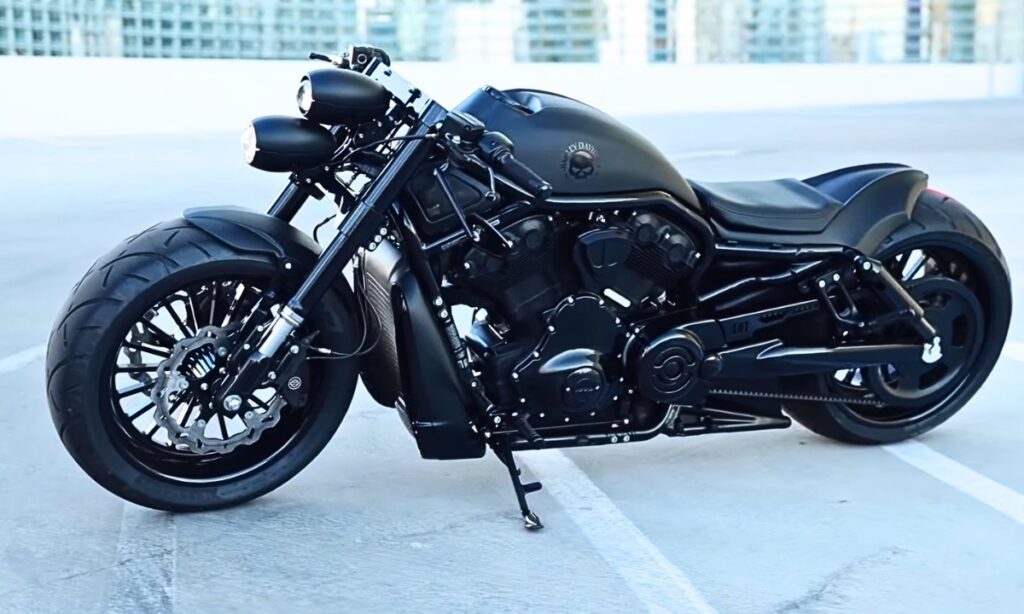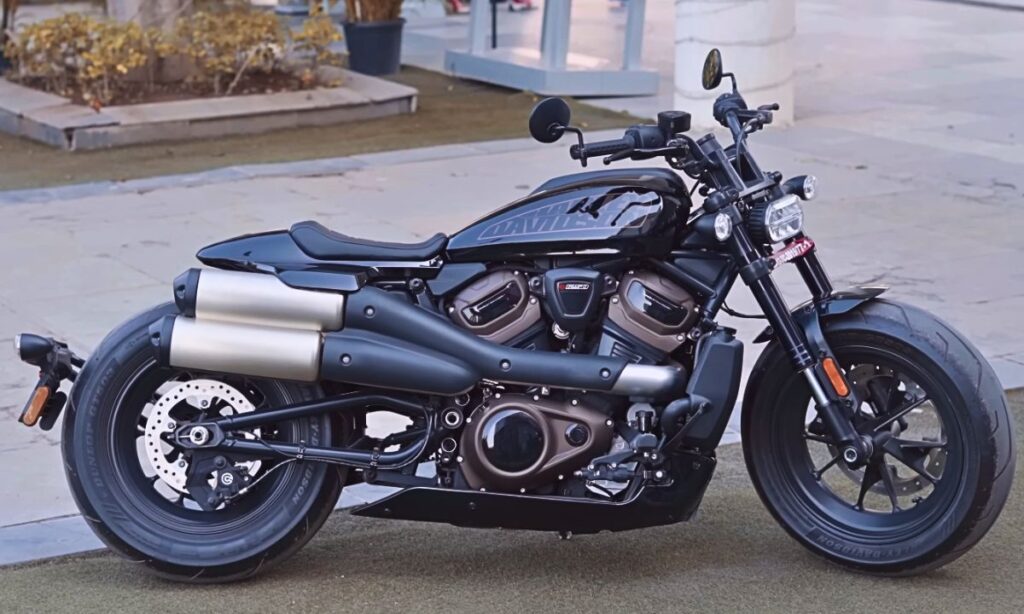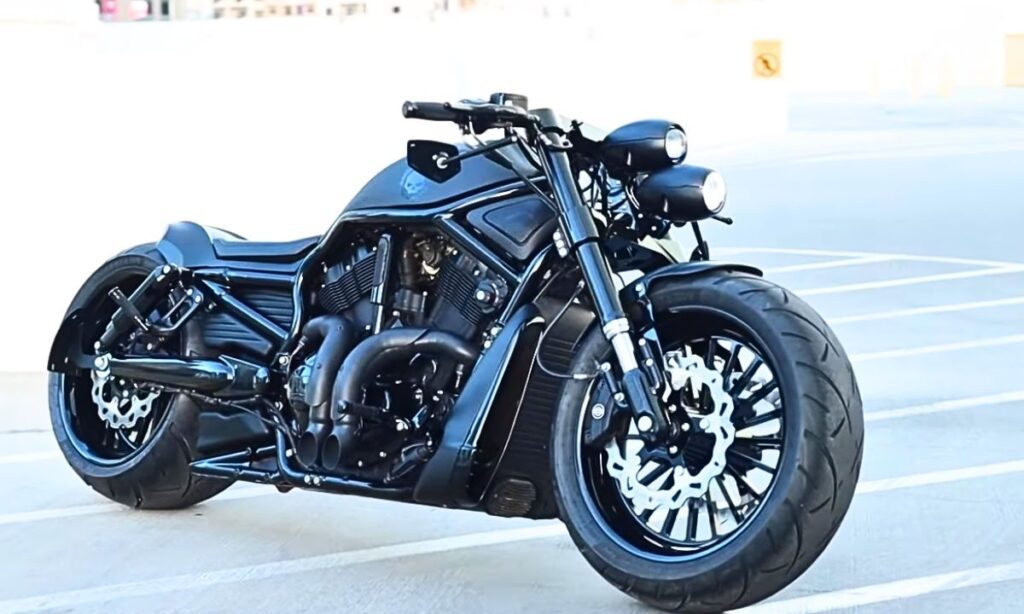The roar of the iconic Harley Davidson motorcycle is unbeatable, and most of the sound comes from its heart engine.
And Harley has introduced various engines over the years with different characters and performances.
If you’re a new rider, then it might be difficult for you to differentiate between the engines.
In this article, we will explore the Harley Davidson engine size chart, which will deliver a clear overview of whether you’re a beginner or a pro rider.
Harley Davidson Engine Size Chart

The Harley-Davidson engine size chart provides an overview of the various engine capacities available for these iconic motorcycles.
Understanding the engine size chart is crucial for riders to choose a Harley-Davidson motorcycle that fits their riding style and experience level.
Here is the engine size chart for the Harley Davidson motorcycles:
| Engine Name | Volume CI |
| Twin Cam 95 | 95ci (1550cc) |
| Evolution (Sportster / Small V-Twin) | 54ci & 73ci (883cc & 1200cc) |
| Twin Cam 103 | 103ci (1690cc) |
| Shovelhead | 74ci & 80ci (1212cc & 1343cc) |
| Twin Cam 88 | 88ci (1442cc) |
| Milwaukee Eight 114 | 114ci (1868cc) |
| F-Head | 61ci & 74 ci (1000cc &1210cc) |
| Twin Cam 96 | 96ci (1584cc) |
| Panhead | 61ci & 74ci (983cc & 1200cc) |
| Milwaukee Eight 107 (Standard) | 107ci (1746cc) |
| Knucklehead | 61ci & 74ci (983cc &1212cc) |
| Twin Cam 88B | 88ci (1442cc) |
| Milwaukee Eight 107 | 107ci (1746cc) |
| Flathead | 45ci & 74ci (737cc & 1212cc) |
| Evolution | 80ci (1343cc) |
| V-Rod (Revolution) | 76ci (1247cc) |
| Twin Cam 110 | 110ci (1800cc) |
| Milwaukee Eight 117 | 117ci (1923cc) |
Harley Davidson Engine Timelines
Harley-Davidson, a name synonymous with American motorcycle culture, has a rich history marked by the evolution of its engine designs.
The journey started in 1909 with the “F-Head,” followed by the robust “Flathead” in the 1920s.
The 1930s saw the introduction of the “Knucklehead,” named for its distinct shape, which set the standard for heavyweight, V-twin engines.
In recent years, we’ve seen the “Evolution” engine, or “Evo,” the “Twin Cam,” and the current “Milwaukee-Eight,” each reflecting Harley-Davidson’s commitment to innovation and performance.
1. The 45 F-Head V-Twin
The Harley-Davidson 45 F-Head V-Twin was introduced in 1919, also known as the “Flathead,” that has secured its place in history for its power and reliability.
The 45 denotes the engine’s displacement in cubic inches, equating to roughly 750cc.
The F-Head V-Twin was built on an innovative design, with its intake valve located in the cylinder head and the exhaust valve placed in the cylinder. This configuration earned it the name F-Head.
While it wasn’t the most powerful engine of its time, the 45 F-Head V-Twin was recognized for its durability and ease of maintenance.
It had a three-speed transmission and left-side throttle, which was an unusual feature at the time but is now standard on most motorcycles.
The 45 F-head continued in service in the Servi-Car (a three-wheeled utility motorcycle) until 1973, showing its presence and reliability.
Today, it’s a favorite among vintage motorcycle enthusiasts who appreciate its simplicity and timeless design.
Whether you’re a collector or a restorer of classic motorcycle engines, the 45 F-Head V-Twin offers a compelling glimpse into an era of ingenuity and mechanical elegance.
2. The Knucklehead
The Knucklehead engine, a seminal invention in the world of motorcycles, was first introduced by Harley-Davidson in 1936.
Named for its distinctive rocker covers that resemble knuckles, this overhead valve V-twin engine marked a turning point in motorcycle design and performance.
It replaced the traditional side-valve engines, bringing about increased power and speed.
With a displacement of 61 cubic inches (1,000 cc) originally, and later increased to 74 cubic inches (1,200 cc), the Knucklehead was characterized by its superior horsepower.
Its featuring overhead valves was coupled with a recirculating oil system, a first for Harley-Davidson, which greatly improved the engine’s life and reliability.
Today, the Knucklehead engine is a prized possession for vintage motorcycle enthusiasts.
Its robust design, power, and iconic status make it a symbol of Harley-Davidson’s rich history.
Maintenance of a Knucklehead engine involves regular oil changes, valve adjustments, and ensuring the integrity of the ignition system for optimal performance.
It is a testament to the quality of the Knucklehead that many of these engines are still in operation today.
3. Flathead V-Twin
The Flathead V-Twin engine, a classic within the motorcycle world, has its roots in the early twentieth century.
It is named for its flat-topped, vented cylinder head, the Flathead engine is a two-cylinder, V-shaped engine with a signature growl that’s synonymous with raw motorcycle power.
This air-cooled engine offers a simple and robust design, making it a popular choice for motorcycle enthusiasts.
It operates with a side-valve configuration, which positions the intake and exhaust valves on the engine’s side, resulting in a compact and efficient design.
Maintenance of the Flathead V-Twin engine is relatively straightforward due to its simplicity.
Regular oil changes, valve clearance checks, and spark plug replacements are essential to keep the engine running smoothly.
However, like all vintage engines, components may wear over time and require replacement.
It is always recommended to consult a professional mechanic or an experienced motorcycle restorer when tackling more complicated issues.
Parts for Flathead V-Twin engines may be scarce or expensive due to their age, but there are dedicated communities and retailers around the world that can assist with sourcing.
4. The Panhead
The Panhead engine, introduced by Harley-Davidson in 1948, is an iconic piece of motorcycle history, revered by enthusiasts for its unique, powerful performance and distinctive aesthetic.
It is named for its pan-like rocker covers, the Panhead engine replaced the Knucklehead engine and was produced until 1965, when it was succeeded by the Shovelhead.
The Panhead came in two versions: the 61 cubic inch (EL model) and the 74 cubic inch (FL model).
Both versions featured numerous improvements over the Knucklehead, including aluminum cylinder heads for better heat dispersion and hydraulic valve lifters, contributing to less engine noise and easier maintenance.
Being a classic motorcycle engine, understanding and maintaining a Panhead engine may require specialized knowledge and tools.
Some of the essential maintenance tasks may be adjusting the valves, changing the oil, and checking and potentially adjusting the timing.
Preserving a Panhead can be a rewarding endeavor, as it is not just keeping a motorcycle running; it’s about preserving a piece of history.
Whether you’re a motorcycle enthusiast or a collector, the Panhead engine stands as a testament to Harley-Davidson’s long-standing commitment to power, reliability, and style.
5. The Evolution
The Evolution engine, frequently referred to as the “Evo” or “Blockhead,” is a series of V-twin engines that was manufactured by Harley-Davidson for its line of motorcycles between 1984 and 1999.
It marked a significant leap forward for Harley-Davidson in terms of design and performance. The Evo engine’s design was a departure from Harley’s earlier Knucklehead and Shovelhead designs.
A key feature of the Evo engine is its aluminum heads and cylinders, as opposed to the iron parts of its predecessors.
This reduced the engine’s weight and improved its cooling, thus enhancing the motorcycle’s overall performance.
The Evolution engine came in two main sizes: the 1340cc for the big twin bikes and the 883cc or 1200cc for the Sportster models.
The 1340cc variant was known for its robustness and reliability, earning the moniker the “Blockhead” because of its square-shaped rocker boxes.
The smaller versions were popular due to their nimbleness and fuel efficiency.
In terms of performance, an Evo engine could generate between 40 to 70 horsepower, depending on the specific model and upgrades.
Despite it being replaced by the Twin Cam engine in 1999, the Evolution engine is still admired by Harley enthusiasts for its simplicity, durability, and classic V-twin rumble.
6. Shovelhead
The Shovelhead engine, an iconic Harley-Davidson motorcycle engine, was produced from 1966 to 1984.
Its name is derived from the distinct shape of the rocker boxes that resemble coal shovels. Here’s a detailed guide on this classic engine:
Overview
The Shovelhead is an air-cooled, 45-degree, V-twin motorcycle engine manufactured by Harley-Davidson. Initially designed with a displacement of 1200cc, it was increased to 1340cc in 1978.
Characteristics
The Shovelhead engine delivers an authentic Harley-Davidson riding experience.
It’s beloved for its simplicity and ease of repair, factors that contribute to its continued popularity among motorcycle enthusiasts.
Maintenance
Regular upkeep of the Shovelhead engine includes oil changes every 2000-3000 miles, valve adjustments at the same intervals, and spark plug replacements as needed.
Always refer to the service manual for more specific maintenance schedules.
Upgrades
Many Shovelhead owners opt for upgrades to improve performance or reliability. Common modifications include electronic ignition systems, updated camshafts, and larger carburetors.
While the Shovelhead engines are considered reliable, they are also vintage engines.
As such, they require a higher level of maintenance and attention than modern engines, in part because of their age and also because they were designed in an era with different standards for noise, emissions, and fuel economy.
7. Twin Cam 88
The Twin Cam 88 engine, also known as the TC88, is a popular model developed by Harley-Davidson.
It was introduced in 1998 and designed to enhance performance and reliability. Here’s a detailed guide about this iconic engine.
Features and Performance
The Twin Cam 88, as indicated by its name, boasts a displacement of 88 cubic inches (approximately 1450cc).
The engine features two overhead cams, one for each cylinder, which leads to better valve timing control and increased power output.
It has a bore and stroke of 3.75×4 inches and a compression ratio of 8.9:1, leading to impressive torque and horsepower figures.
Maintenance and Servicing
Regular maintenance is vital to keep the Twin Cam 88 running smoothly. Typical service intervals involve oil changes every 5,000 miles and spark plug replacements every 10,000 miles.
It’s also crucial to inspect the air filter, belts, and hoses regularly.
Upgrades and Modifications
Numerous upgrades are available for the TC88, including big bore kits, performance camshafts, and upgraded exhaust systems, allowing you to customize the engine’s performance to your liking.
Troubleshooting Common Issues
Although the Twin Cam 88 is renowned for its reliability, some common issues can arise, such as high oil consumption or overheating.
These problems can often be rectified by ensuring regular maintenance, installing oil coolers, or upgrading the engine’s oil pump.
Understanding your Twin Cam 88 engine and its requirements can lead to a more pleasurable riding experience with your Harley-Davidson.
By investing time in regular maintenance and potential upgrades, you can ensure your engine runs smoothly for years to come.
8. Milwaukee-Eight
The Milwaukee-Eight engine, a product of Harley-Davidson, is the ninth in a lineage of iconic Big Twin motors. It was introduced in 2016 to replace the Twin Cam engine.
This powerhouse comes in two variations: the 107 (1753cc) and the 114/117 (1868cc/1923cc).
Both boast four valves per cylinder, which improves the motor’s intake and exhaust flow efficiency, leading to a ten percent increase in torque over the Twin Cam engines.
The Milwaukee-Eight engine also innovates with a single chain-driven camshaft, contrary to the Twin Cam’s two.
This design minimizes the engine noise and makes the engine more mechanically efficient.
Another appreciable feature of the Milwaukee-Eight engine is the counterbalancer, which eliminates 75% of the engine’s vibration at idle.
This leads to a smoother ride, reducing rider fatigue over long journeys. The cooling system of the Milwaukee-Eight engine is also noteworthy.
The 107 and 114 come in two versions: air-cooled and twin-cooled, where liquid coolant cools the heads around the exhaust ports to deliver enhanced rider comfort.
The Milwaukee-Eight engine is not just an engine; it’s a leap forward in motor design for Harley-Davidson, offering smoother rides and more powerful machines that still capture the classic Harley feel.
9. The V-Rod
The Harley-Davidson V-Rod, also known as the VRSC, is a unique marvel in the world of motorcycles with its powerful liquid-cooled engine.
Introduced in 2001, the V-Rod engine, co-developed with Porsche, marked a departure from Harley-Davidson’s traditional air-cooled engines.
This 60-degree, V-twin engine displaces 1,131 cc (69 cu in) and is fueled by electronic sequential port fuel injection (ESPFI).
The engine’s liquid-cooling system is designed for optimal performance and longevity, a significant improvement over previous Harley-Davidson models.
The engine can produce up to 115 horsepower at 8,250 RPM and 74 lb-ft of torque at 7,000 RPM.
This results in a 0-60 mph time of about 3.59 seconds, providing the V-Rod with impressive acceleration.
The Revolution engine also features dual overhead cams and 4-valves per cylinder, which increase airflow and, in turn, power.
The engine’s hydroformed frame contributes to its sleek, racing-inspired design while also providing a well-balanced ride.
In terms of maintenance, the V-Rod engine requires regular service at intervals of 5,000 miles. This includes oil changes, checking spark plugs, and inspecting the coolant system.
The V-Rod engine is an innovative feat, combining Harley’s iconic V-twin design with modern engineering tactics, resulting in a powerful, high-performing engine.
It stands as a testament to Harley’s ability to adapt and evolve, bringing a new edge to their classic motorcycle line-up.
How many cc is a Harley engine?
Harley-Davidson motorcycles are famed for their high-performance engines. The cubic capacity (cc) of these engines varies across different models.
For instance, the Harley-Davidson Sportster models typically feature engines with a capacity of 883cc or 1200cc.
On the other hand, the engines in the Harley-Davidson Softail or Touring models, such as the Milwaukee-Eight 107 and 114, have capacities of approximately 1745cc and 1868cc, respectively.
It’s notable that the brand’s motorcycle engines range from around 500cc for the smallest, up to 1923cc for the largest production models.
How many cc is a Harley 88 engine?
The Harley Davidson 88 engine, also known as the Twin Cam 88, has a displacement of 1,450 cubic centimeters (cc).
This engine was introduced in 1999 and remained in production until 2006, powering a wide range of Harley-Davidson motorcycles during this period.
Which Harley has the biggest engine?
The Harley-Davidson motorcycle boasting the largest engine currently available is the Harley-Davidson CVO Road Glide.
This impressive motorbike comes equipped with the Milwaukee-Eight 117 engine, the biggest engine ever offered by Harley-Davidson for mass-market use.
Its powerful engine has a displacement of 1,923cc (117 cubic inches), boasting high power and torque for an exhilarating riding experience.


Talha Younas, the brains behind the influential motorcycle-focused website, TwoWheller.com, is a dedicated and passionate advocate for biking culture. Born and raised in a family of motorcycle enthusiasts, his love for two-wheeled transportation was ignited at an early age. His commitment to providing in-depth reviews and helpful tips for riders has established him as a respected figure in the motorcycle community.

